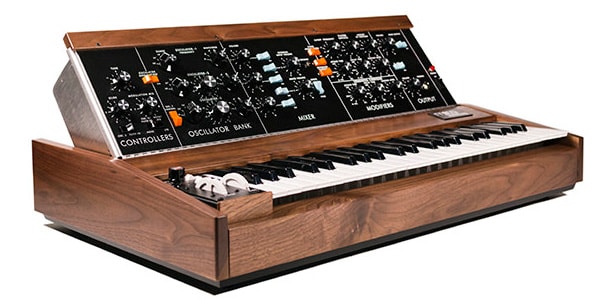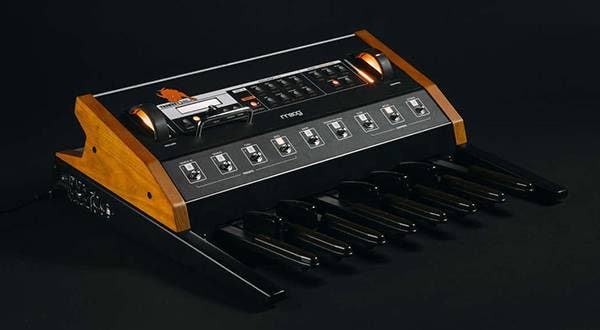This time, I’ll take a broad look at the internals of an analog synthesizer. When it comes to iconic analog synths, Moog is a name that stands out, both in the past and present. It all began with the Moog Modular System in 1964, which, despite being monophonic, gained widespread use around the world. Among these, the compact monophonic Minimoog, released in 1970, became a model with many devoted users. When people think of Moog, many likely envision Minimoog. Even today, it’s available as a reissue and can still be acquired.
Minimoog 1970 – Approximately 500,000 yen at the time
The Minimoog has its modules pre-wired, which sacrifices some flexibility, but it makes it much easier to use. The control panel is organized in a way that the signal flow of the sound moves from left to right, making it easy to understand. While I will primarily use images and waveforms of the Minimoog here, I will also look at concepts that are common to analog synthesizers in general.
■ Signal Flow

The internal structure of an analog synthesizer can be broadly divided into the following three parts.
- Oscillator (VCO, OSC): Generates waveforms as electrical signals and outputs them to the filter.
- Filter (VCF): Performs subtractive processing to shape the sound and outputs it to the amplifier.
- Amplifier (VCA): Controls the volume over time and outputs it externally.
In order to produce sound, the ON/OFF and pitch are controlled from the keyboard, etc. Furthermore, the expressive power is enhanced by modulating the audio signal using LFO (low-frequency oscillator) and envelope generator (ADSR).
■ Oscillator (VCO, OSC)
The oscillator generates the base waveforms. Electrically, it continuously outputs a waveform with a constant period through an oscillation circuit. The signal from the oscillator has a constant volume and remains a waveform with no variation. Oscillators are typically designed to output waveforms such as sine, sawtooth, square waves, and noise. Many analog synthesizers have 2 to 3 oscillators, which are used in combination. In the case of the Minimoog, there are oscillators that allow you to choose from three waveforms, as well as a dedicated noise oscillator.

Pitch is controlled by voltage. The control voltage range is approximately 0 to 12V, with one volt increase corresponding to a one-octave rise, or the frequency changes proportionally to the voltage. The Minimoog uses the former method.
To create specific waveforms, different circuits are required. In the early days of synthesizers, circuits were constructed using general-purpose components such as operational amplifiers, transistors, FETs, capacitors, resistors, and diodes. In the case of the Minimoog, looking at the circuit diagram, it appears that the early Fairchild μA741 operational amplifier was used in key areas. The oscillator circuitry is primarily built around transistors and FETs. Overall, the circuit has a large number of components and is quite complex.
Even though the names of the waveforms are the same, different circuits will produce different waveforms, so the sound impression can vary greatly depending on the model and manufacturer. The waveforms are compared to the ideal waveforms, with the Minimoog’s waveforms shown for comparison. All are waveforms at 440Hz. Additionally, analog synthesizers often have waveforms that change shape depending on the frequency, with the lower frequencies being more distinctive.
Sine Wave
The sine wave is essential in experiments, but it is not always necessary in synthesizers. Especially in the subtractive synthesis method, where harmonics are removed to shape the sound, it is not a crucial waveform, and the Minimoog does not include it. An analog circuit to generate a sine wave includes the Wien Bridge oscillator, which uses a bandpass filter to create positive feedback and oscillate.

Instead of a sine wave, the Minimoog can generate a triangle wave. The generation process is relatively simpler than that of a sine wave.

Sawtooth Wave
The ideal waveform looks like the following. It has sharp edges and contains all integer harmonics. A sawtooth wave oscillator using operational amplifiers and capacitors is quite popular.

The sawtooth wave on the Minimoog is quite distorted. In analog synthesizers, circuits often use capacitors, and the charging and discharging characteristics of the capacitors tend to create a slanted line in the waveform. As expected, the waveform changes depending on the frequency range.

Square Wave
The ideal square wave produces a parallel waveform. Circuits that use comparators (voltage comparators) to alternately switch between positive and negative power supplies are commonly used. Many synthesizers allow the duty cycle to be adjusted, and the Minimoog also offers three different options to choose from.

On the Minimoog, the waveform is somewhat distorted. As the pitch lowers, it becomes even more irregular.

Noise
This is white noise, which contains all frequencies evenly. There are various methods of generation, such as applying voltage to a Zener diode to generate white noise.

This is the white noise of the Minimoog.

In the case of noise, it’s difficult to understand just by looking at the waveform, so let's look at the frequency spectrum. By examining this, we can see that the noise from the Minimoog is not flat, with the levels of both the low and high frequencies dropping.

■ Filter (VCF)

The sound output from the oscillator is processed by the filter to shape the tone. There are various types of filters, such as LPF (Low-Pass Filter), HPF (High-Pass Filter), and BPF (Band-Pass Filter), but all of them decide which frequency range to pass through or cut. The most commonly used filter in synthesizers is the LPF (Low-Pass Filter). The LPF sets a cutoff frequency, lowering the levels of frequencies higher than that. This method of sound creation is called subtractive synthesis because it works by subtracting frequencies. The Minimoog is equipped with a 4-pole ladder filter, which is an LPF circuit based on transistors, and it produces a distinctive sound. As the number of poles increases, the slope of the filter generally becomes steeper. The Minimoog’s 4-pole filter (4th order) creates a 24dB/octave slope. In the video below, you can observe how the high-frequency components are cut when the cutoff frequency is lowered.

When an LPF has a steep slope, a level bump called "ripple" appears at the cutoff frequency. Acoustically, this can sound unnatural, so it is usually avoided, but in synthesizers, it is actively used in sound design. The interesting part is how the pure audio approach and the musical instrument approach are completely opposite in this case.
The knob that emphasizes the ripple is commonly referred to as "resonance." In the Minimoog, it is labeled as "EMPHASIS." The video below shows the frequency spectrum when the EMPHASIS is adjusted up and down. A peak appears at 2kHz, which is determined by the cutoff frequency.

To add even more dynamic variation, an envelope generator (ADSR) is often used to control the voltage over time and create distinctive, synthesizer-like sounds. Filters are where the characteristics of the manufacturer and model are most noticeable, and there are significant differences in the changes when turning the knobs.
■ Amplifier (VCA)

The amplifier is the part that amplifies the sound, but it is also where the envelope generator (ADSR) adjusts the volume changes over time and ultimately shapes the final tone. The envelope generator is an essential component in modern synthesizers. ADSR stands for Attack, Decay, Sustain, and Release, and each knob functions as follows. The Minimoog omits the Release control and instead uses a switch to toggle between Decay and Release.
- A (Attack): Adjusts the time it takes for the sound to reach its peak after pressing the key.
- D (Decay): Adjusts the time it takes for the sound to drop to the Sustain level after reaching its peak.
- S (Sustain): Adjusts the volume while the key is held down.
- R (Release): Adjusts the time it takes for the sound to fade out after releasing the key.

■ LFO (Low-Frequency Oscillator)
The LFO outputs low-frequency waveforms such as sine waves to modulate the audio signal. Specifically, this results in a sound that has a vibrato effect. If applied to the oscillator, the pitch will fluctuate, and if applied to the amplifier, the volume will fluctuate.
■ Analog Synthesizers Are Primarily Monophonic
Early synthesizers were predominantly monophonic, meaning they could only produce one note at a time, and the Minimoog is also monophonic. The desire to produce chords existed from the beginning, but achieving polyphony while maintaining the synthesizer's structure would require multiple synthesizers, making it very expensive. However, starting in the late 1970s, polyphonic analog synthesizers, such as the Prophet-5, Oberheim OB-X, and Roland JUPITER-8, which internally contained multiple voices, were introduced. However, none of these were affordable for the general public.
Prophet-5 (1978, 5-voice, approximately 1.7 million yen)

Prophet-5, Public domain (quoted from Wikipedia)
Oberheim OB-X (1979, 4, 6, 8-voice, 1.8 to 2.4 million yen)

Oberheim OB-X, Public domain (quoted from Wikipedia)
Roland JUPITER-8 (1981, 8-voice, 980,000 yen)

Roland Jupiter-8 Synth, CC BY-SA 2.0 (quoted from Wikipedia)
Another method to achieve polyphony with analog circuits is using a frequency divider circuit. Moog also introduced the Polymoog in 1975, which utilized a frequency divider circuit. I will explain polyphonic instruments using frequency divider circuits in the next discussion.
■ The Decline and Revival of Analog Synthesizers
By the 1980s, the development of digital technology and integrated circuits made it possible to create inexpensive digital synthesizers, leading to the decline of expensive analog synthesizers. However, after the year 2000, analog synthesizers made a comeback. There must have been something appealing about the opposite approach compared to the mainstream sampling sources and software synthesizers. This revival coincided with the resurgence of vinyl records, so the return to analog cannot be dismissed as just a passing trend. In any case, it is a delightful thing that past technological assets are being passed down.
The “sound & person” column is made possible by your contributions.
For more information about contributions, click here.















![[2025 Latest Edition] Choosing a Synthesizer/Popular Synthesizers Ranking](/contents/uploads/thumbs/2/2022/9/20220916_2_19446_1.jpg)
![[2025 Latest Edition!] Popular Modular Synthesizer/Semi-Modular Synthesizer Ranking [Recommendations]](/contents/uploads/thumbs/2/2021/12/20211202_2_15495_1.jpg)

 自分にあったピアノを選ぼう!役立つピアノ用語集
自分にあったピアノを選ぼう!役立つピアノ用語集
 各メーカーの鍵盤比較
各メーカーの鍵盤比較
 用途で選ぶ!鍵盤楽器の種類
用途で選ぶ!鍵盤楽器の種類
 キーボードスタートガイド
キーボードスタートガイド
 キーボード・ピアノ講座
キーボード・ピアノ講座
 DTM・DAW購入ガイド
DTM・DAW購入ガイド















